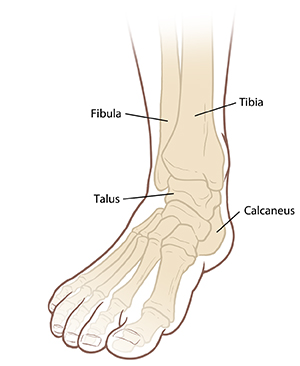Ankle fusion (ankle arthrodesis) is a surgery to join two or more bones of your ankle. It's usually done to treat arthritis in the ankle.
The ankle joint
A joint is a place in the body where bones meet. The ankle joint is composed of two joints. One is called the true ankle joint. The shinbone (tibia), fibula (the smaller bone of the lower leg), and talus bones make up this joint. The second ankle joint is the subtalar joint. It's made up of the talus and calcaneus bones.
Why ankle fusion is done
Arthritis may make it hard for you to walk and do other daily activities. Surgery is an option when other treatments haven’t worked well. These may include exercises, bracing, injections, medicine, and heat or cold. Ankle fusion surgery can help stop the pain and improve quality of life. The surgery removes the remaining cartilage from the ankle joint. The bones in the joint are then attached together with screws, plates, nails, or other hardware.
How ankle fusion is done
Your ankle fusion will be done by an orthopedic surgeon. This is a surgeon who specializes in treating bone, muscle, joint, and tendon problems. The surgery can be done in several ways. The surgeon will make one or more cuts (incisions) through the skin and muscle of your ankle. An incision may also be made on your foot. If you have minimally invasive surgery, the incisions will be small. Your surgeon will remove cartilage from the affected joint. The bones in the joint will then be put together in the right position. They will be attached with screws, plates, nails, or other hardware. A bone graft may be used to help the bones heal together.
Risks of ankle fusion
A normal side effect of ankle fusion is that you will have less range of motion in the joint. This isn’t a big problem for most people.
Every surgery has risks. Your risks vary based on your age and general health. For example, if you are a smoker or if you have low bone density, you may have a higher risk for certain problems such as slower healing. People with diabetes may also have a higher risk for problems. These can include poor healing or infections. Talk with your surgeon about which risks apply most to you. The risks of ankle fusion include:
-
Infection.
-
Damage to nearby nerves.
-
Bleeding.
-
Blood clots.
-
Bones not joining together properly.
-
Misalignment of the bones.
-
Painful hardware.
-
New arthritis in nearby joints. (This is very common.)


